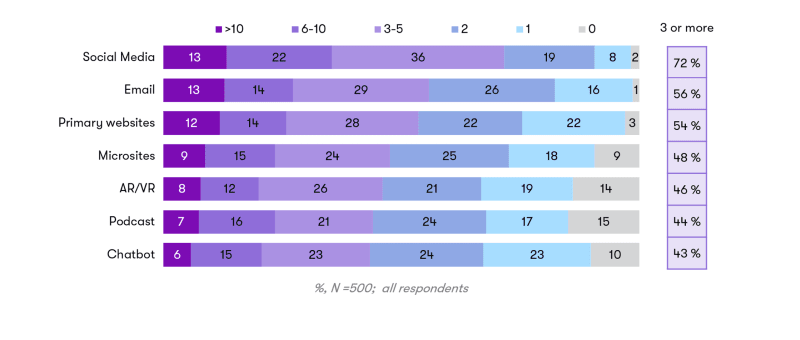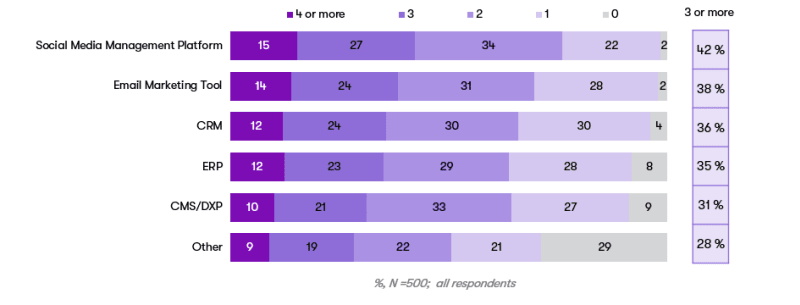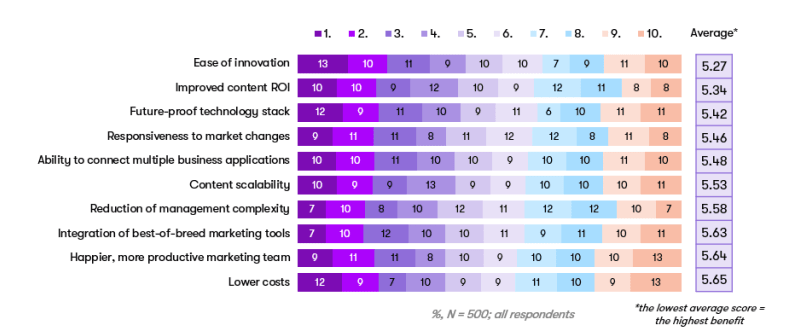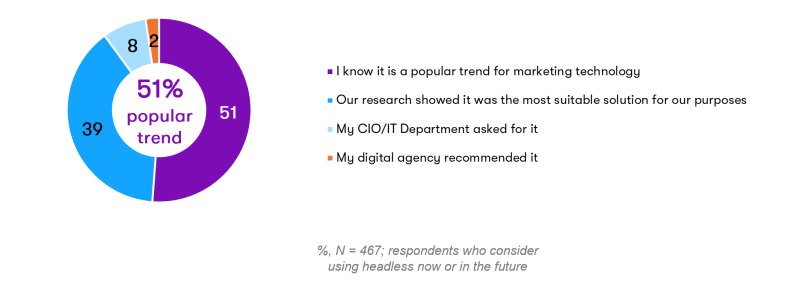In today's digital age, businesses are constantly seeking new ways to reach their target audience and expand their online presence. Kentico recently carried out an online survey to gain insights from marketing leaders about their use of various digital channels and their impressions and use of headless technology for digital marketing purposes.
The survey gathered quantitative research from 500 CMOs, VPMs, and digital marketers working in companies based in USA, Canada, UK, Ireland, Germany, Netherlands, France, Belgium, Australia, and New Zealand, with between 250-3000 employees.
The multifaceted nature of marketing channels
Our findings show that most companies are using two to five individual channels in their digital marketing efforts, with social media a top choice.

A staggering 72% of marketers are using three or more channels for social media marketing, underlining the pivotal role social media plays in marketing strategies.
Email marketing continues to be a robust avenue for businesses, with an impressive 56% of respondents using three or more email channels to communicate with their audience.
Interestingly, 54% of marketers say they are maintaining three or more primary websites, which we interpret to mean a combination of main website, community sites, regional websites, partner portals, members-only sites, etc.
Companies with a larger developer headcount (primarily based in Australia and New Zealand), tend to embrace a more extensive range of digital marketing channels, which can be attributed to the increased resources and expertise available.
Platform proliferation in digital marketing
When we asked respondents how many platforms/services they were using to run these digital marketing channels, a fractal emerged:
- 42% are managing three or more social media tools (27% use three, 34% use two).
- 38% of respondents rely on three or more email marketing tools.
- 33% of respondents are using two content management systems (CMS) or digital experience platforms (DXP), while 31% are leveraging three or more.
- 36% of respondents manage three or more customer relationship management (CRM) platforms.
- 35% of respondents have three or more enterprise resource management (ERP) platforms in play.
Once again, as the number of in-house developers increases, so does the number of platforms.

This research proves it’s very common for marketers to use many platforms to engage customers across many channels.
While embracing multiple marketing channels is essential for engaging diverse audiences, it also leads to a growing number of platforms and services. As companies navigate this intricate relationship, they must carefully consider tech stack complexity.
Headless technology to the rescue?
Our recent survey reveals that headless technology (where the front end is decoupled from the back end) has garnered significant attention among marketers.
Of those exploring its potential, 43% are doing so to facilitate seamless content sharing across all digital marketing channels. An additional 39% are eyeing headless for sharing content with external websites and apps. There's also a forward-thinking 11% who are considering it for the future, hinting at a continued growth trajectory for headless capabilities as more businesses recognize its value in delivering content effectively.
The United States leads the headless charge, with 50% of companies using or considering headless. In contrast, companies with headquarters in Europe, the Middle East, Africa, or Asia are slightly more reserved, with 35% showing interest.
In terms of using headless capabilities for sharing content on all digital channels, Digital Marketers are most eager, with 51% saying they use it or are considering using it for this purpose. 49% of Chief Marketing Officers (CMOs), Vice Presidents (VPs), and Directors of Marketing exhibit enthusiasm in using it for this purpose, while only 18% of Content Managers, who play a pivotal role in content creation and management, do.
Why the trend towards headless?
Unlike traditional monolithic CMSs, headless CMSs or DXPs decouple the content management backend from the presentation layer, freeing marketers and developers from the constraints of a fixed website structure.
Marketers can seamlessly deliver content to various channels, including websites, mobile apps, third-party websites, and even emerging technologies like voice assistants, and can make real-time changes to content without the need for complex coding or website redeployments.
They can reuse content across all channels which not only makes them more efficient but makes content governance easier. They can better maintain consistent branding and messaging across all channels, enhancing the customer experience and brand cohesion and can swiftly adapt to changing market trends, consumer preferences, or emerging opportunities. This agility is especially valuable in industries where staying up to date and responsive to the market is critical.
Headless technology is also designed to adapt to emerging technologies and platforms. As new channels and devices emerge, marketers can seamlessly integrate them into their strategy without the need for extensive redevelopment. This futureproofing ensures that businesses can stay ahead in a rapidly evolving digital landscape.
“Do you use, or are you considering, the use of ‘headless’ for content delivery this year?”

Our survey results show that marketers are exploring diverse applications for headless content delivery, with 43% focusing on sharing content across all digital marketing channels. This approach not only ensures content consistency but also enhances the flexibility to adapt to various platforms and devices. 39% consider headless systems a way to extend content reach to external websites and apps.
The biggest perceived benefits for marketers adopting headless technology include (in order of importance):
- Ease of innovation. > Headless capabilities play a pivotal role in enabling companies to remain agile, explore new ideas, and adapt swiftly to changing market conditions.
- Improved content ROI. > By efficiently managing content and reusing it across various platforms, companies can enhance the ROI of each item of content produced.
- A future-proof technology stack. > Headless APIs ensure that technology infrastructures remain relevant and adaptable as needs change and the business evolves.
- Responsiveness to market changes. >Headless capabilities enable businesses to respond swiftly and effectively to market changes.

What’s the catch with headless technology?
According to our survey, 39% of decision-makers have chosen or are considering headless because research has indicated that it's the most suitable solution for their unique needs and a noteworthy 8% of respondents revealed that they were asked to use headless.
But the big reveal is that more than half (51%) of businesses have chosen or are considering headless primarily because it's perceived as a popular trend in the marketing technology landscape.
“Why did you consider headless?”

Throwing yourself at every marketing trend is a slippery slope, and one that can undo all your marketing efforts.
Pure headless technology (where the entire solution is headless) comes with its benefits but can present real challenges, as the back end (content storage and management) is separate from the front end (presentation layer). This makes managing content in a pure headless environment more complex, and marketers often face challenges in creating, organizing, and updating content due to the lack of an integrated CMS or DXP. This might lead to a steeper learning curve for marketers accustomed to traditional, more marketer-friendly interfaces.
What’s more, additional development effort is required on the front end to ensure a seamless user experience. Marketers may need to collaborate more closely with developers to implement changes or updates, slowing down the content creation and deployment process.
Adopting a pure headless approach often requires a higher level of digital maturity within the organization. It assumes a robust understanding of the underlying technologies, APIs, and integrations. Marketers and teams need to be well-versed in these aspects to navigate the complexities effectively.
According to our survey, fewer than half (just 39%) of marketers say they have chosen or are considering headless because it's the most suitable solution for their unique needs. This is alarming. It’s important for decision-makers to take a step back from the hype and really ask themselves what sort of solution will actively support their goals with the resources they currently have.
Hype in the market is a big concern, and one that we at Kentico actively avoid—in how we build our product (we don’t jump on technology bandwagons until we’ve proven it’s of real benefit to our customers), and how we sell it (we don’t push our product on customers who won’t get the most out of it).
Before diving into headless, learn more about the benefits and drawbacks of headless solutions, and explore alternatives like hybrid-headless solutions which combine the marketer’s autonomy of a traditional CMS with the multichannel delivery of headless.
Navigating complexity: the tech stacks of modern companies
While embracing multiple marketing channels is essential for reaching diverse audiences, it also leads to a growing number of platforms and services. In this intricate landscape, careful consideration of tech stack complexity is imperative.
To navigate this complexity and streamline their digital landscape, companies must prioritize several key principles:
- Consolidation: Bringing essential tools together into a unified solution simplifies the tech stack, making it more manageable and efficient.
- Composability: Selecting solutions that seamlessly integrate with existing and future tools ensures that various systems work harmoniously.
- Centralization: Managing all content and data from one place within a single platform maintains a cohesive tech stack and content management experience.
- Scalability: Choosing solutions that can scale with the business's growth and evolving needs prevents technology bottlenecks and ensures adaptability.
- The right headless approach: Don’t fall for hype. Choose headless only if it really helps you meet your goals. For ultimate flexibility, explore hybrid-headless solutions.
In the realm of multichannel digital marketing, tech stack simplification is the cornerstone of efficiency and success. As the digital landscape continues to evolve, consolidation of your tech stack and centralization of your content management is crucial, as is choosing the right headless approach for your specific needs.

